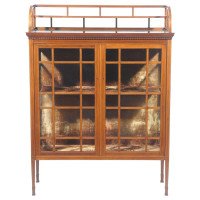Arthur Heygate Mackmurdo for the Century Guild. an Important Art Nouveau Chair
POA
Width: 20 in (50.8 cm)
Depth: 19 in (48.26 cm)
1880-1889
About this piece
Arthur Heygate Mackmurdo (1851-1942), a highly important oak chair, with an Art Nouveau floral back. Mackmurdo's influence in Europe is recognized as having produced the earliest examples of Art Nouveau, particularly in the styling of a chair-back designed in 1882 and the title page for Wren's City Churches a year later. The present chair was designed for the head of Rainhill hospital St Helen's south Lancashire/ Merseyside (now demolished), an institute for the mentally ill, as part of an interior scheme for his study. It was almost certainly designed and made only for this interior, unlike the earlier chair which was designed in 1882 and made and sold until 1888. It was originally thought this interior was designed by the Liverpool architect Edmund Rathbone whose brother, Harold Rathbone, founded the Della Robbia Pottery factory in 1894. A picture is shown in Jeremy Cooper's Victorian and Edwardian Furniture and Interiors, p. 199, illus. 516, from the Bedford Lemere archive at the National Monuments Record, apparently credited as ' Rainhill, Edmund Rathbone'. But Edmund Rathbone was actually the Century Guild Representative in Liverpool at that time. ( Thanks to Stuart Evans for help in this provenance. ) Like the 1882 chair this one has quite conventional framing but here infilled with twisting foliage in an Art Nouveau manner to the back. It is established that the Century Guild's work was known to the Belgian avant garde group Les X X ( Les Vingt) and this piece can only add weight to Mackmurdo's reputation as a precursor of Art Nouveau. This is one of the important pieces designed by Macmurdo that undeniably predict Art Nouveau and herald the fashion that went on to explode throughout Europe not only in furniture design but in architecture, metalwork, lighting, ceramics and glass: a sinuous explosion flooding through the veins of the young designers who were emerging in France, Belgium, Prague, Italy, Spain and the rest of Europe at the turn of the century. See Cooper, Jeremy Victorian and Edwardian Furniture and Interiors p. 199, illus. 516 (from the Bedford Lemere archive at the National Monuments Record) for this chair in situ and p. 198 illus. 514 for the comparable example of 1882. Mackmurdo was born in 1851, the year of the Great Exhibition, the son of a wealthy chemicals manufacturer who showed his goods there. He was educated at Felsted School in Essex, and started his architectural career articled to T. Chatfield Clarke before entering the office of James Brooks. Later in life Mackmurdo credited the value of the example of methodical thoroughness set him by Brooks. At Oxford in 1873 he attended lectures by John Ruskin and drawing classes he ran. Ruskin had an enormous influence on the young Mackmurdo. The following year he accompanied Ruskin to Italy. Florence was an awakening feast to his artistic thirst for knowledge. All his early training had been in Gothic Architecture and Florence was nothing less than a revelation. He fell passionately in love with the Renaissance something that stayed with him throughout his lifetime and so set the seeds of Art Nouveau. In 1877 he met William Morris through his membership of the Society for the Protection of Ancient Buildings, who inspired further his keen interest in the applied arts. He set up his own architectural practice at 28 Southampton Street, London and in 1882 he founded ' The Century Guild' to produce decorative work in every field of interior design and 'to render all branches of art the sphere no longer of the tradesman but of the artist, it would restore building decoration, glass painting, pottery, wood carving and metalwork to their rightful place beside painting and sculpture'. His associates in this venture were Herbert Horne, Selwyn Image, Heywood Sumner, Kellock Brown, Benjamin Creswick, George Esling, Clement Heaton and William De Morgan who's decorative tiles they used and sold through the company. They complimented each other enormously with an impressive array of artistic skills. The Guild's products included furniture, stained glass, metalwork, lighting, fabrics and wallpaper. This was to include the magazine, ' The Hobby Horse', which first went on sale in 1884, and was printed at the Chiswick Press and beautifully illustrated with woodcuts by Selwyn Image and Herbert Horne and other contributors included D. G. Rossetti, William Bell Scott and Ford Madox Brown. The Guild's first appearance was at the Inventions Exhibition in London in 1885, though fame and recognition didn't arrive until they exhibited again at the Liverpool International Exhibition in 1886. Mackmurdo's output included design work for the Savoy Hotel (1889), a house in Chelsea for the artist Mortimer Menpes (a stunning Japanese-style interior), and interiors at Pownall Hall, Cheshire. The Century Guild designed two stands and a pavilion at the Liverpool international exhibition of 1886, and Mackmurdo designed a pair of houses north of the city,
circa 1880, and a spa hotel in Nantwich which lies to the south of the city in an area of salt mining in Cheshire,
circa 1882 (since demolished and contents dispersed). Age 51 he married Eliza D'Oyly Carte and moved to Wickam Bishops in Essex where he built his home Great Ruffins. He retired age of 55, his later interests were in social reform and he died at the ripe old age of 91. I have attached images taken before I had it re upholstered so one can see in and around the seat frame. The images were taken at a different time and those look a little lighter the first images show it's true colours.
























